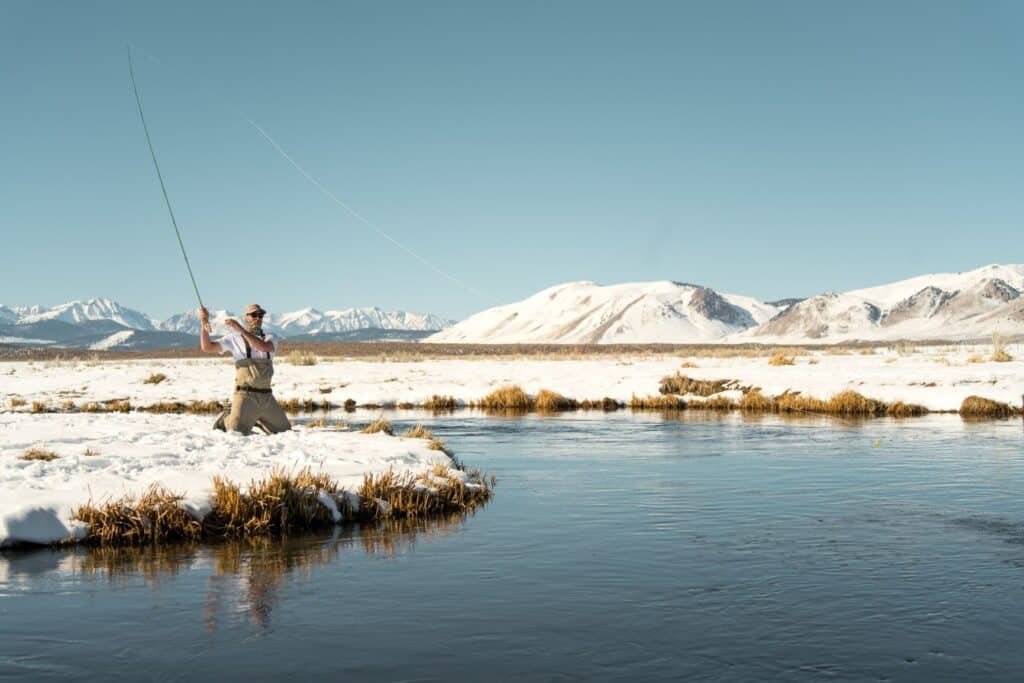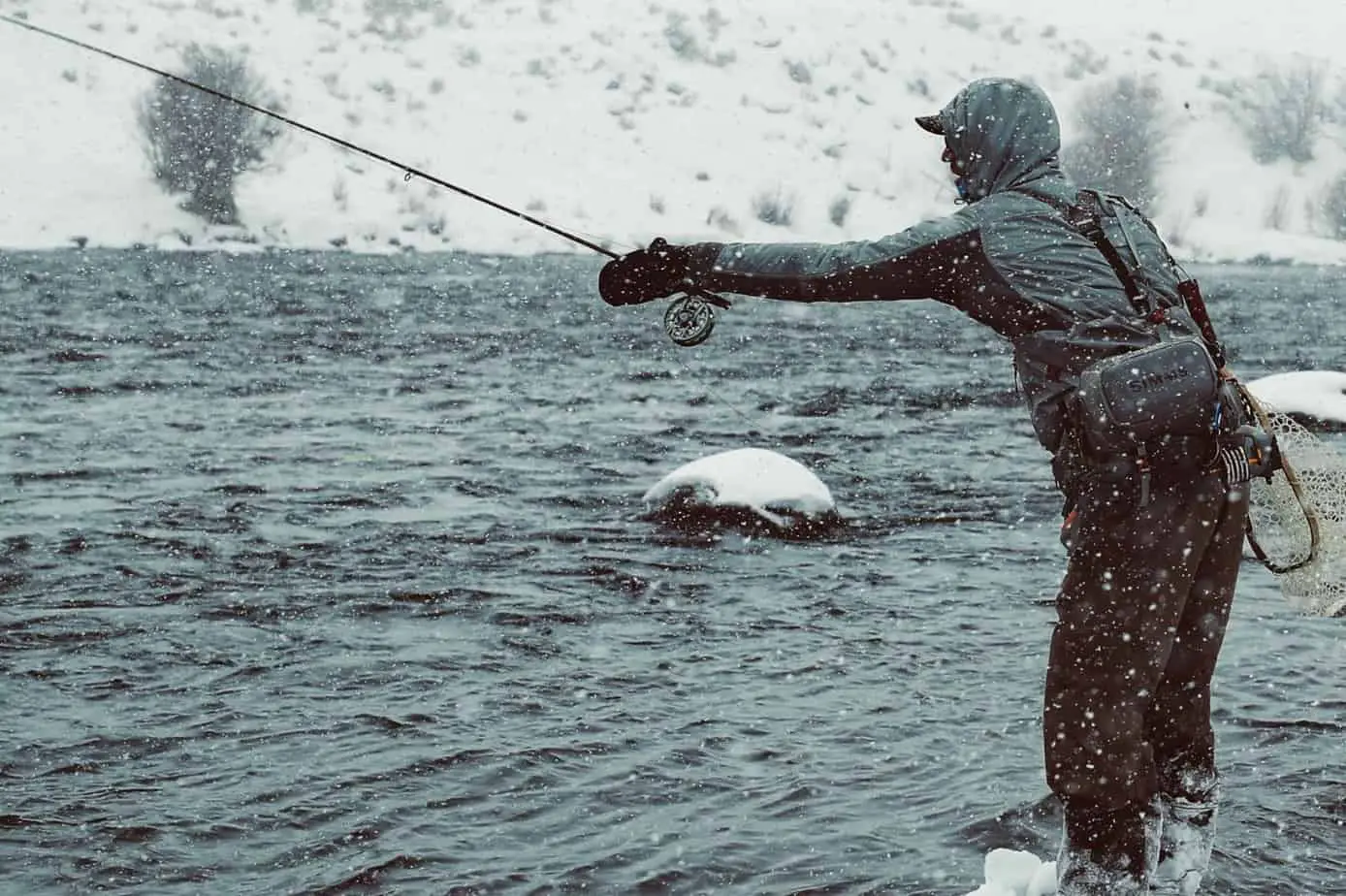Who would want to go fly fishing in the winter? Well, a lot of fly fishers. Winter is a fantastic time to hit the water and target those trophy fish.
When fly fishing in the winter, wear:
- Thermal underwear or base layer
- Moisture-wicking mid-layers
- Insulated Top Layer
- Rain Gear, if necessary
- Waders
- Gloves and Hat
Winter fly fishing differs from fly fishing in other seasons. You will use slightly different techniques, equipment, and flies. The biggest change comes in what you would wear. Because the conditions are different from the other seasons, you need to prepare accordingly.
Without the proper knowledge, it can be dangerous to fly fish in the winter. Thankfully, that is why we are here today.
Here is a beginner’s guide on what to wear when fly fishing in the winter.
Base Layer
The first step in dressing for any season is the base layer. However, the base layer is far different in the winter than in any other season. This might be an essential part of your clothing to consider because this is the first layer that will help keep you warm.
Depending on your local climate, it could be 55 degrees or 5 degrees in the winter. Well, what you wear specifically will differ, but the general idea stays the same. When the weather is cold, you need to take your base layer very seriously.
A base layer is the closest layer of clothing to your body. These are made to conserve as much body heat as possible. With the summer base layers, they are meant to keep you cool and wick moisture. While winter base layers want to wick moisture, it is also to keep heat from escaping.
These usually take the shape of long underwear. Thermal tops and bottoms make excellent base layers and are rated to keep you warm. Many of the options out there are polyester or some sort of blend, so moisture-wicking is still a priority.
If you would like to compare winter base layers to summer ones, click here.
Mid Layers And Top Layer
Once you have a base layer established, build on top of it next. How far you take it will depend on your climate, but we will talk about what is necessary when it gets really cold.
Layering is key to being outside in the winter. We all know those super puffy down jackets that make you sweat just by looking at them. Those are usually no good in these situations. You want to replace that oversized jacket with several thinner layers.
If you wear one big jacket, if you get hot and take it off, you will be instantly cold again. There is no middle ground. Wearing multiple layers allows you to regulate your body heat very efficiently.
So, above your base layer, you should start stacking pullovers, hoodies, and light jackets. How many you wear depends on how cold it is. The colder it is, the more layers you should have. Generally speaking, having 2-3 layers sandwiched between your base layer and the final top layer is usually good. When you get hot, you simply shed a layer. When you get cold, you add one.
Blended materials that include polyester and nylon are excellent because they will wick moisture while also keeping you warm.
Top layers are really self-explanatory. Your top layer should be a jacket that is warm, durable, and comfortable. A great way to handle your top layer is by making it your rain jacket.

An increasingly popular option is to wear an electric heated vest, like this one from Venustas. Heated vests and jackets give you more warmth without all the layers. Venustas makes men’s and women’s heated jackets and vests that are perfect for chilly mornings on the water.

Rain Gear
Rain gear is so important in any season, but especially in the winter. There are two main goals whenever you are outside in the winter: stay warm and stay dry. Both of these aspects work together very closely. Since we already covered how to keep warm, it is time to talk about keeping dry.
Being wet in cold weather is the easiest way to get frostbite or hypothermia. Although being damp and cold in the summer is bad, it is much easier to recover from. Once you are compromised in the winter, you have to act fast, or things will be nasty.
The best way to stay dry is by investing in high-quality rain gear. Winter rain gear is going to differ from summer rain gear. In the summer, rain gear can be light, small, and very thin. In the winter, it is quite the opposite. Although you can get rain gear that works in any season, there are specific cold weather jackets and setups to protect you from the elements.
For winter raingear, thickness and quality are both keys. You want a rain jacket that can also double as a coat to keep you warm. These will be more expensive, but they will be more durable and last longer. There are some great companies like Simms and The North Face that make this style of rain jacket.
If this isn’t in your price range, you can use a regular coat and invest in a thinner rain jacket to put over the top of it. This will work just as well, but you may want it to all be one piece.
You also want a winter rain jacket to be as waterproof as possible. This is why buying a quality jacket is so important. The cheaper the jacket, the more likely it is to give out and lose its properties.
Buying an excellent rain jacket that can fit your budget is one of the most important things you can do, especially when fly fishing in the winter.
Waders
One of the most critical aspects of your winter fly fishing outfit is waders. In fly fishing, you will generally be in the water targeting fish. This allows you to get a fantastic vantage point.
Specifically to the winter, full over the shoulder waders are the best. These provide excellent insulation and protection. You also want to beef the waders up in the winter. In the summer, you can get away with thinner waders because the water isn’t as cold. In the winter, the water can be deadly, so you want insulation.
If you can’t get your hands on thick waders, you could always layer up with pants underneath. You want your waders to pose as both protection from the water and a way to keep your body warm.
You can also opt to use hip waders, which aren’t as high, but they can still do the job. We recommend staying away from boot waders because these are really small and won’t add much warmth.
Gloves And Hat
Finally, we have some of the essential add-ons that are specific to winter fly fishing. One of which is a winter hat. Almost all of your body heat escapes through the bottom of your feed and the top of your head. Since you hopefully already have warm socks and waterproof boots on, you should add a winter hat into the mix.
These all come down to personal preference. You probably want a winter hat that will keep your head and ears warm.
The other big add-on is gloves. Many fly fishing purists won’t use gloves, even when the temperature is low, but they offer a lot to you. Your hands are your main tools while fishing, so keeping them safe, dry, and warm is huge.
Conclusion
Fly fishing in the winter has some unique challenges. What you’re wearing may be the difference between landing a trout or hypothermia.
Even if you’re not interested in fishing in the middle of January, cold weather fly fishing gear can at least extend your season. Or it may help you access new fly fishing destinations that may have weather patterns than you’re used to.
And don’t forget to review our other articles on what to wear when fly fishing:


